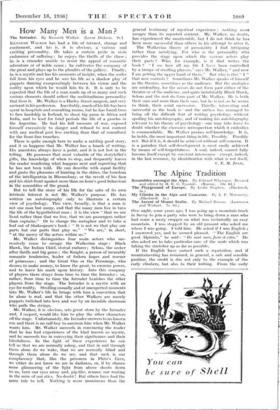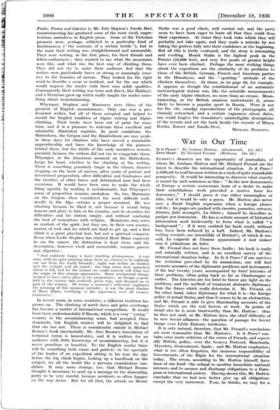The Alpine Tradition
Scrambles amongst the Alps. By Edward Whymper. 'Revised and edited by H. E. G. Tyndale. (Murray. 10s. 6d.) The Playground of Europe. By Leslie Stephen. (Blackwell. 5s.) My Climbs in the Alps and Caucasus. By A. F. Mummery. (Blackwell. 5s.) The Ascent of Mount Stalin. By Michael Romm. (Lawrence and Wishart. 7s. 6d.) ONE night, some years ago, I was going up a mountain-track in Savoy to join a party who were to bring down a man who had come a nasty cropper on what was technically an easy mountain. I was stopped by an old peasant who asked me where I was going. I told him. He asked if I was English ; I answered yes, and he seemed pleased. "The English are good Alpinists," he said : "Its sent sure, forts et rites.." He also asked me to take particular care of the mule which was taking the stretcher up as far as possible.
If the English have earned such a reputation, and if mountaineering has remained, in general, a safe and sensible pastime, the credit is due not only to the example of the early climbers, but also to their writing. From the early Peaks, Passes and Glaciers to Mr. Eric Shipton's _Wanda Devi, mountaineering has produced some of the most vivid, unpre- tentious narratives in English prose. Some of the Victorian pioneers were, perhaps, addicted to a particular kind of facetiousness (" the contents of a certain bottle "), but in the main their writing was straightforward and memorable.
They were writing, in the first place, for their friends and fellow-enthusiasts ; they wanted to say what the mountains were like, and what was the best way of climbing them. They did not try to make their audience feel that the writers were particularly brave or strong or amazingly sensi- tive to the beauties of nature. They looked for the right word to describe a scene or incident, not for the one which would impress the reader with their own noble qualities. Consequently their writing was terse and direct, like Hakluyt, and a literature grew up which really taught the reader some- thing about mountaineering.
Whymper, Stephen and Mummery were three of the greatest of English mountaineers. Only one was a pro- fessional writer, but all of them accepted and helped to mould the English tradition of Alpine writing and Alpine climbing. Their books have been out of print for some time, and it is a pleasure to welcome these excellent and admirably illustrated reprints. In good conditions, the Matterhorn, the Grepon and the Zinalrothom are easy peaks in these days for climbers who have served a reasonable apprenticeship and have the knowledge of the pioneers behind them, but the thrills of the early narratives remain, precisely because the writers did not try to exaggerate them. Whymper, at the disastrous moment on the Matterhorn, keeps his head, whether in the climbing or the writing. There is something genuinely tragic in the climax, disaster stepping on .the heels of success, after years of patient and determined preparation, after difficulties and hindrances and the rivalries of other brave and determined men had been overcome. It would have been easy to make the whole thing squalid, by making it melodramatic, but Whymper's sense of proportion remains unshaken. So, too, Mummery on the Grepon—then considered the most difficult rock- needle in the Alps—retains a proper standard. He was climbing because he liked it, not because it would bring honour and glory to him or his country, and he describes his difficulties and his elation simply, and without confusing the best of recreations with religion. Mountains may serve as symbols of the spirit, but they are, in their own essence, masses of rock and ice which are hard to get up, and a first climb is a great physical feat, but not a spiritual conquest. Even when Leslie Stephen has climbed Mont Blanc expressly to see the sunset, the distinction is kept clear, . and the description, however vivid and memorable, remains precise and objective :
"And suddenly began a more startling phenomenon. A vast cone, with its apex pointing away from us, seemed to be suddenly cut out from the world beneath; night was within its borders and the twilight still all round ; the blue mists were quenched where it fell, and for the instant we could scarcely tell what was the origin of this strange appearance. Some unexpected change seemed to have taken place in the programme ; as though a great fold in the curtain had suddenly given way, and dropped on to part of the scenery. Of course a moment's reflection explained the meaning of this uncanny intruder ; it war the giant shadow of Mont Blanc, testifying to his supremacy over all meaner eminences."
In recent years, in some countries, a different tradition has grown up. The climbing of north faces and grim overhangs has become a matter of international competition. It would have been understandable if Russia, which is a very " young " country in the mountaineering sense, had accepted these standards, but English readers will be delighted to find that she has not. There is considerable naivete in Michael Romm's book (incidentally, Mr. Alec Brown's translation of technical terms is lamentable), and it is written for an audience with little knowledge of mountaineering, but it is
never grandiose or boastful. To the English reader there will be something both comic and pathetic in the spectacle of the leader of an expeditioa sitting in his tent the day before the big climb begins, looking up a handbook on the subject, for all the world like a nervous examination can- didate. It may seem strange, too, that Michael Romm thought it necessary to send up a message to the descending
party to be very careful, because accidents so often happen on the way down. But for all that, the attack on Mount
Stalin was a good climb, well carried out, and the party seem to have been eager to learn all that they could from their experience. At times they took risks which they will probably not take again, and they made a mistake by not taking the porters fully into their confidence at the beginning. But all this is freely confessed, and the story is interesting and exciting. Mount Stalin is the highest peak in the Pamirs (24,600 feet), and very few peaks of greater height have ever been climbed. Perhaps the most striking things about the expedition are the similarity of its problems to those of the British, German, French and American parties in the Himalayas, and the " sporting " attitude of the climbers themselves. At times, as on page 26, for example, it appears as though the establishment of an automatic meteorological station was, like the scientific measurements of the early Alpine climbers, no more than an excuse. Moun- taineering, as the British amateur understands it, seems likely to become a popular sport in Russia. Were it not for the vile, smudgy reproductions of the photographs, all clumsily retouched, and a certain vagueness about dates, one could forgive the translator's unintelligible descriptions of the terrain and set the book beside the records of Minya
Konka, Kamet and Nanda Devi. MICHAEL ROBERTS.











































 Previous page
Previous page